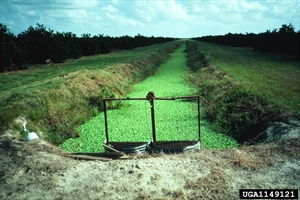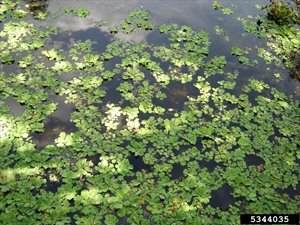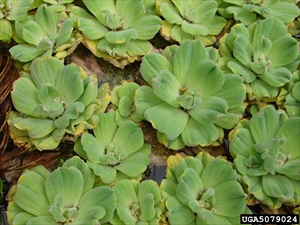- Widespread. Asia, Africa, North, South and Central America, Caribbean, Europe, Oceania. In many Pacific islands.
- Invasive free-floating freshwater weed. Major weed of lakes, dams, ponds, irrigation channels, and slow-moving waterways, forming mats that prevents water travel, destroys rice paddies, and kills native biodiversity.
- Plants, with grey-green leaves, single or connected by short stems, up to 60 cm long. Leaves, fan-shaped, 2.5-15 cm, 6-15 obvious veins, on short stalks, covered in soft white hairs trapping air bubbles for buoyancy. Flowers, clustered on small fleshy stalks. Fruit, many-seeded green berries, sink, later germinating in the shallows. Roots, numerous and feathery
- Spread: rapid vegetative reproduction; seed, by boats and fishing nets; use as aquatic ornamental.
- Biosecurity: high risk of introduction via aquarium trade; On Global Invasive Species Database of alien invasive species (IUCN, 2020). Noxious weed in South Africa and parts of USA. Available on internet.
- Biocontrol: weevil, Neohydronomous affinis, released in Africa, PNG, USA; moth, Spodoptera pectinicornis, reported in Thailand.
- Cultural control: check nutrient levels (important); floating booms; manual removal (rakes), leaving on shore to dry for 2 months; mechanical harvesting, chopping, returning as a spray.
- Chemical control: in Australia: glyphosate; 2,4-D; carfentrazone-ethyl. In Fiji, MCPA.









